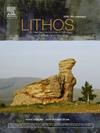Serpentinization of the Ronda Massif (Spain): Structural controls and fluid origin
IF 2.9
2区 地球科学
Q2 GEOCHEMISTRY & GEOPHYSICS
引用次数: 0
Abstract
Serpentinization is a ubiquitous hydrothermal alteration of ultramafic rocks. In the Ronda Massif (Andalusia, Spain), which represents the largest body of subcontinental peridotite exposed at the Earth surface, most studies focused on high-temperature deformation and petrology of mantle rocks. Serpentinization remains poorly constrained. Petro-structural and O and H isotope investigations allow us to identify three successive stages of serpentinization. The first stage of serpentinization is characterized by a widespread lizardite mesh-texture. The extent of serpentinization indicates a regional gradient, with a low proportion of serpentine (around 15 %) in the core of the Sierra Bermeja Massif. The second stage corresponds to highly localized serpentinization, characterized by the presence of lizardite, bastite and high content of magnetite. The third stage was intimately associated with brittle deformation, consisting of fibrous veins and a coating network within cataclastic shear zones. Structural analysis of shear veins of the third serpentinization stage enables identification of a regional syn-serpentinization extensional deformation that corresponded to a multi-directional horizontal stretching and a vertical shortening direction (i.e., flattening). All stages of serpentinization display comparable isotopic compositions, with the mean of δ18O values at ∼ +5.0 ‰ and δD at ∼ −80.5 ‰, suggesting that the two last stages occurred under conditions of fluid-rock interactions that preserved the compositions acquired during stage 1. The fluid source for this stage 1 was likely deeply seated, with a possible contribution of meteoric-derived fluids. Stage 3 serpentinization occurred at 170 ± 50 °C based on magnetite-serpentine isotopic equilibrium. We propose a model of continuous serpentinization that occurred during the rapid exhumation of the Ronda Massif during the Early Miocene period. The syn-serpentinization extensional brittle deformation we document may be compatible either with orogenic thickening (i.e., syn-thrusting) or with early post-thickening collapse.
龙达山丘(西班牙)的蛇纹石化:结构控制和流体起源
蛇纹岩化是超基性岩普遍存在的热液蚀变现象。龙达丘陵(西班牙安达卢西亚)是暴露在地表的最大的亚大陆橄榄岩体,在这里,大多数研究都集中在高温变形和地幔岩石岩石学方面。对蛇纹岩化的研究仍然很少。岩石结构以及 O 和 H 同位素研究使我们能够确定蛇绿岩化的三个连续阶段。蛇纹石化的第一阶段以广泛的蜥蜴石网状纹理为特征。蛇纹石化的程度呈现区域梯度,在贝梅哈山脉地块的核心区域,蛇纹石的比例较低(约 15%)。第二阶段是高度局部的蛇纹石化,其特征是存在蜥蜴石、韧皮石和高含量的磁铁矿。第三阶段与脆性变形密切相关,由纤维状矿脉和弹塑性剪切带内的涂层网络组成。通过对蛇纹石化第三阶段剪切脉的结构分析,可以确定区域性的同步蛇纹石化延伸变形,该变形与多方向的水平拉伸和垂直缩短方向(即扁平化)相对应。蛇绿岩化的所有阶段都显示出相当的同位素组成,δ18O 的平均值为∼ +5.0‰,δD 为∼ -80.5‰,这表明最后两个阶段是在流体与岩石相互作用的条件下发生的,保留了第一阶段获得的组成。第一阶段的流体来源可能是深层流体,也可能是陨石流体。根据磁铁矿-蛇绿岩同位素平衡,第三阶段蛇绿岩化发生在 170 ± 50 °C。我们提出了一个在早中新世时期龙达丘块快速掘起过程中发生的连续蛇绿岩化模型。我们所记录的同步蛇绿岩化延伸脆性变形可能与造山增厚(即同步推移)或增厚后早期崩塌相一致。
本文章由计算机程序翻译,如有差异,请以英文原文为准。
求助全文
约1分钟内获得全文
求助全文
来源期刊

Lithos
地学-地球化学与地球物理
CiteScore
6.80
自引率
11.40%
发文量
286
审稿时长
3.5 months
期刊介绍:
Lithos publishes original research papers on the petrology, geochemistry and petrogenesis of igneous and metamorphic rocks. Papers on mineralogy/mineral physics related to petrology and petrogenetic problems are also welcomed.
 求助内容:
求助内容: 应助结果提醒方式:
应助结果提醒方式:


